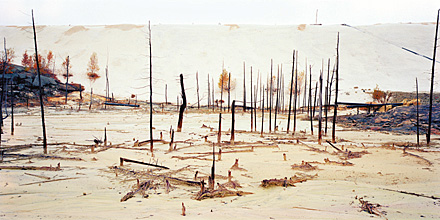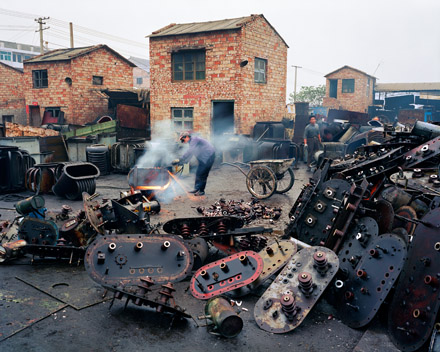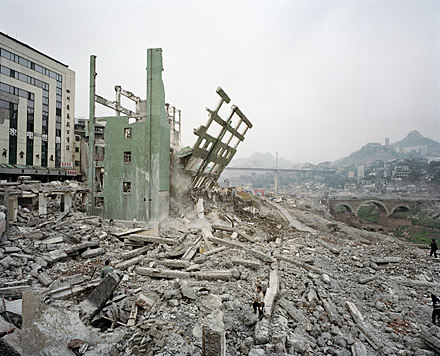This is a post from September last year; I’m republishing it here because it has ongoing relevance.

By Frosty Wooldridge, Denver Post
Re: “High, Dry and Devastated” Pankratz/9/17/08 Denver Post
When you realize humans kill 100 million sharks in the planet’s oceans annually, you scratch your head in dismay, or, at least, consternation. Unknown to most humans, thousands of species suffer extinction at the hands of humanity annually. (Source: Life, August , 1991, “Sharks: Predator becomes prey” Fussman)
When you read startling headlines in the Denver Post announcing devastating drought, you scratch your mind further as to why humans steam forward as if they cannot be touched by nature’s vengeance. What do we possess in our arrogance as to denial of our own vulnerability in the scheme of life?
At a Gamow lecture at Colorado University, Boulder, Colorado, I listened to a lecture by Oxford University professor Dr. Norman Meyers. He explained his personal research in the Amazon and other rain forests around the world that humans cause the extinction of 50 to 100 species every day of the year. I didn’t think much of it until, I too, visited the Amazon.
Humans burn 1.5 acres every second in the Amazon and worldwide to make way for crops in the shallow soils of the rain forests. What forms the foundation of the Amazon rain forests? Answer: sand dunes! Note that the Amazon rain forests took millennia to cover those dunes with minimum topsoil. Once exhausted, farmlands become wastelands.
As I explored the Amazon, I watched roads being built into its interior all the way to Manous on the Amazon River. I saw firsthand the fires and the relentless cutting of huge trees. Animals and plants lose their homes at a rate of a landmass the size of Colorado every year. No wonder Myers reported 100 species suffer extinction daily!
Back in the United States, famed Harvard biologist E.O. Wilson states, “We cannot save the planet if we don’t understand it.”
I might add that we cannot save our planet home if we fail to stabilize human population growth. But never mind, because in the end, Mother Nature WILL stabilize human population growth, rather brutally.
In an excellent report, Mark Matousek, “Rescuing Earth” said, “The man widely considered to be Charles Darwin’s heir wants to build an ark, a virtual one at that.”
“It will be the greatest scientific achievements of the 21st century,” Wilson, 79, said. “We need this information about our world in order to save it.” Wilson expects to identify earth’s creatures in his “Encyclopedia of Life.” Estimates project 30 million species inhabit this planet.
While Wilson’s quest promotes noble intentions, first of all, humans rampage across the planet with devastating results to our ecological systems, but in the end, we cannot ‘save it’. A harsh reality faces humanity: this planet can and will erase humans without shedding a tear or issuing a burp!
The sad aspect of our destroying the environmental foundation of the planet in the past 100 years: we drive the sixth extinction session of millions of fellow creatures by our irresponsible fecundity.
“Scientists agree that the world has entered the first great extinction to be caused by humans,” Matousek said. “Global warming, deforestation, abuse of arable land, and destruction of natural habitats threaten to wipe out half the species of plants and animals on the planet by the end of the century.”
Wilson said, “Half the world’s plant and animal species could be extinct by the end of the century.”
As someone who witnessed massive kill-off of species in the Amazon, I direct your attention to a movie starring Sean Connery: “Medicine Man”.
By viewing the movie, you may see the species loss by their habitat cut and burned into oblivion. Not discussed in this sixth extinction session, you might consider what I call the “cascade effect”. For an example, in the United States, prairie dogs suffer horrific destruction of their colonies via human development. In states like Colorado, that slaps asphalt and concrete on 100,000 acres annually, those rodents vanish overnight.
When prairie dogs die, 67 other species, which depend on the rodents, also suffer decline and extinction. Voila! “Cascade effect”!
By not taking time to identify earth’s biodiversity, “It’s like a doctor trying to treat a patient knowing only 10 percent of the organs,” Wilson said.
As a scientist, Wilson suffers the slings and arrows of the Committee Against Racism and religious groups, but his scientific integrity remains unquestioned.
If humanity expects to flourish into the 21st century, it must take action with its intellect rather than its emotional and religious paradigms that prove outdated, outmoded and irrelevant. E.O.Wilson leads the struggle to bring about a viable future on planet Earth.
##################################
Bob Woodruff of ABC asked input from all citizens concerning the future of our planet. Go to www.earth2100.tv for a sobering reality check as to what we face and to what I have been writing about for the past 20 years. Our ‘window’ to change to a balanced population and non-polluting energy diminishes every day we listen to irresponsible media and thus ignore the blatant symptoms manifesting all over America and the planet.
To take action: www.numbersusa.com ; www.thesocialcontract.com ; www.fairus.org ; www.Capsweb.org ; www.vdare.org ; www.proenglish.org ; www.alipac.us ; www.firecoalition.com ; www.patriotunion.org
Become a member of “Frosty’s Press Agent Corps” whereby you volunteer a few hours to send out emails to top TV and radio hosts to offer top speakers on America’s overpopulation crisis driven by unending immigration. Email frostyw@juno.com and receive two informational letters showing you exactly what to do.
Frosty Wooldridge has bicycled across six continents – from the Arctic to the South Pole – as well as six times across the USA, coast to coast and border to border. In 2005, he bicycled from the Arctic Circle, Norway to Athens, Greece. He presents “The Coming Population Crisis in America: and what you can do about it” to civic clubs, church groups, high schools and colleges. He works to bring about sensible world population balance at www.frostywooldridge.com
From: Frosty Wooldridge
This three minute interview with Adam Schrager on “Your Show” May 4, 2008, NBC Channel 9 News, addresses the ramifications of adding 120 million people to USA in 35 years and six million people to Colorado as to water shortages, air pollution, loss of farmland, energy costs and degradation of quality of life. In the interview, Frosty Wooldridge explains the ramifications of adding 120 million people to the USA in 35 years. He advances new concepts such as a “Colorado Carrying Capacity Policy”; “Colorado Environmental Impact Policy”; “Colorado Water Usage Policy”; “Colorado Sustainable Population Policy”. Nationally, the USA needs a “National Sustainable Population Policy” to determine the carrying capacity of this nation for the short and long term. Wooldridge is available for interviews on radio and TV having interviewed on ABC, CBS, NBC, CNN and FOX.
Click the link to view the 3 minute interview with NBC’s Adam Schrager:
http://www.9news.com/video/player.aspx?aid=52364
Frosty Wooldridge
www.frostywooldridge.com
 A man checks his phone below a giant poster at the Mobile World Congress in Barcelona. PICTURE: AP
A man checks his phone below a giant poster at the Mobile World Congress in Barcelona. PICTURE: AP







![Reblog this post [with Zemanta]](https://i0.wp.com/img.zemanta.com/reblog_e.png)






